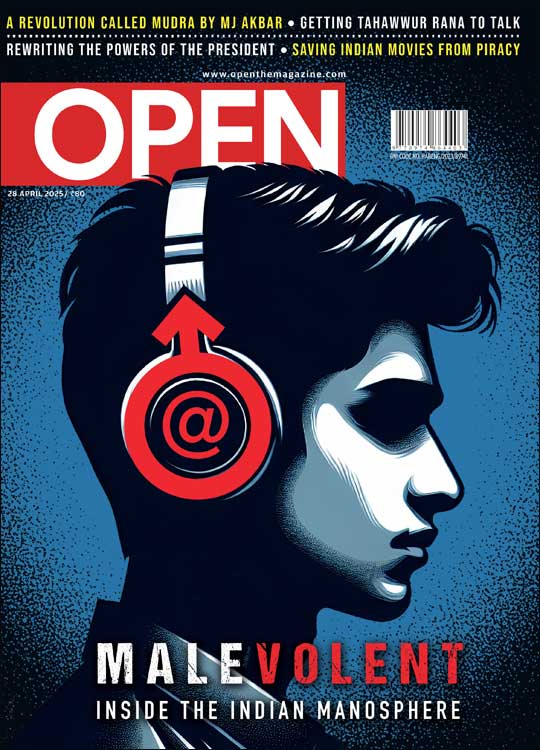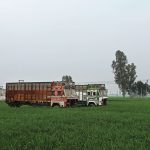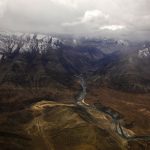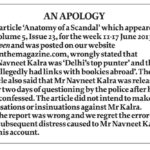The Last Moments of Paana
The dramatic story of Paan Singh Tomar’s death, as reconstructed from the accounts of two eyewitnesses. On one side, a former police officer who led the encounter that killed him. And on the other, the dacoit’s nephew and former gang member who survived that 12-hour gunfight in October 1981
 Arindam Mukherjee
Arindam Mukherjee
 Arindam Mukherjee
|
25 Mar, 2012
Arindam Mukherjee
|
25 Mar, 2012
/wp-content/uploads/2015/11/paan-3.jpg)
The dramatic story of Paan Singh Tomar’s death, as reconstructed from the accounts of two eyewitnesses.
“Like a mythical demigod emerging from the scarred earth, with his enormous stamina and steeplechase leap, Subedar Paan Singh Tomar of Bhidosa lives on in the Chambal, his strange legend as a champion athlete and dreaded killer within the same lifetime refusing to sleep”
— recitation of a balladeer in Bhind, Madhya Pradesh
GWALIOR ~ Retired police officer Mahendra Pratap Singh Chauhan suspected all along that the release of Paan Singh Tomar would make the dacoit by that name, rather than him, an object of hero worship. The movie’s director Tigmanshu Dhulia had contacted him for his version of Paan Singh Tomar’s death, and he had helped the filmmaker to the best of his memory. But that’s all. He had no interest in watching the film or basking in any attention it would get him.
In any case, Chauhan’s character makes just a flash-by appearance in the movie (at the end). Its final encounter scene is shot with Paan Singh in close focus, with anonymous shapes in the form of policemen firing from a darkened distance. But, in real life, his was among the rifles that fired the fateful bullets that finally got Paan Singh, killing this champion athlete-turned-brigand.
It was on 1 October 1981 that Circle Inspector Chauhan and his team of six trapped and killed Paan Singh along with ten of his dreaded gang members after a gunfight that lasted more than 12 hours. The police suffered no casualty, which was no small feat in itself, given the gang’s fearsome reputation. On Republic Day 1984, Madhya Pradesh Governor KM Chandy awarded Chauhan the President’s Police Medal for Gallantry.
Chauhan, who was posted back then at Gohad police station, 50 km north of Gwalior, gave Dhulia a detailed account of the encounter. After the film was released, people goaded him to go to Kailash Talkies, a local movie theatre, and watch it. But Chauhan, recovering from a brain haemorrhage that partially disabled him two years ago, was just not interested. “All of Paan Singh’s clan will be showing off in cinema halls now, foolishly boasting that this movie is about them,” scoffs the police officer who retired as a deputy superintendent of police, having served the Madhya Pradesh Police’s anti-dacoity wing for 40 years.
But what really peeves Chauhan, even though he had an inkling of it, is Paan Singh’s portrayal as a hero in the film, as he’s heard. “It’s a movie about a criminal, and I am sure it glorifies a killer. Why would I go to the theatre to watch such a movie?” he asks indignantly, “Paan Singh had a criminal bent of mind right from the beginning. I don’t care if he served the Army or won medals for the country. He was a killer and deserved a violent end.”
Now 71 years old, Chauhan lives with two servants in a two-storey home in a residential colony of Gwalior. He still keeps four guns hidden at home, both as defensive weapons and memorabilia: as an officer fighting dacoits, these were vital to his existence. Paan Singh’s was just one of the many encounters he braved in his career as a cop. He was even shot in the leg during an operation once.
He was a 20-year-old sub-inspector at Gohad police station when he had his first gunfight. It was with the gang of a notorious dacoit, Mohar Singh. The police killed three of Mohar’s men. Chauhan, seeing death up close for the first time, had a hard time holding his nerve. At one point, he recalls, he froze. His rifle was loaded, its safety catch unlocked, but he just couldn’t fire. “It was gory. The fall of a human body, the convulsions, the way the palms clutch the earth before death… I saw all that and forgot my trigger.” Chauhan was punished for inaction: he was made to draft in detail the panchnamas (autopsies) of ten bodies. After that, death seemed like just another matter of routine. As he soon found, its stench was never too far in the air of the Chambal, this “baaghiyon ka beeharh” (ravine of outlaws), as he likes to call it.
Death was no big deal, no big deal at all. Not for the police, not for the bandits. This was the Chambal, after all. A judge once asked a Chambal dacoit called Laxman Dixit, alias Lukka daaku, how many people he had killed in his 14-year career. Dixit’s response: “Do you remember how many chapatis you eat in a month?”
Recorded accounts of looting and kidnapping in this region can be traced back to Harshvardhan’s reign (606-647 CE). The Chinese traveller Huen Tsang was emptied of his pockets near the present day town of Dholpur, less than a few kilometres from Paan Singh’s main hideout. Dacoit gangs flourished in the Rajput era too. There are tales of outlaws rising in rebellion against King Prithviraj Chauhan. Even Mughal Emperor Babur, according to his memoirs Baburnama, had to brace himself for dacoit attacks on his march southward of Delhi.
One of the first major fugitives of 20th century Chambal was the patriotic Ram Prasad Bismil (1897-1927) from Rugar Barbai, a village on the banks of the River Chambal in Morena district. Famous for his poem Sarfaroshi ki Tamanna, Bismil was hanged to death by British imperialists for his role in looting a treasury train at Kakori, a heist that was to gain fame as the Kakori Conspiracy.
After India’s Independence, the nature of banditry changed. Several renegades took to the ravines for a variety of reasons, being cast out by a casteist social order not least among them. Many saw themselves as revolutionaries, out to overturn the lives of those who’d dealt them some form of injustice or another. ‘Dasyuraj Paan Singh Tomar, Chambal ka sher’ (King of dacoits and tiger of Chambal), as the dacoit would sign his ransom notes, was no different. A Kshatriya by caste and a subedar in the Bengal Engineer Group of the Indian Armed Forces at Roorkee, Paan Singh became an outlaw after a land dispute with his cousins that saw them turn tormentors so brutal that they thrashed his son Hanumant Singh black and blue and nearly killed his frail 90-year-old mother with riflebutt blows. His pleas for help ignored by both the panchayat and local police, Paan Singh turned baaghi—rebel.
Within months, he had shot three of his cousins dead—Havaldar, Babbu and Jandel Singh. After that vendetta, the athlete fondly called Paana by his teammates, the man who ran for India at the Tokyo Asiad in 1958, broke the national records for 3000m steeplechase (1958) and 5000m (1959) for the Services, and was often part of the same team as Milkha Singh, knew that he could never recover his former life again.
That’s not all. In 1977, Paan Singh and his gang of 28 massacred nine Gujjar men in Pawa Paota village, 40 km north of Gwalior, to avenge the death of his elder brother Matadeen—who he thought had been betrayed to the police by the village sarpanch. The news of these killings brought then Chief Minister Arjun Singh to tears. “I will not light a lamp on Diwali until Paan Singh is caught,” the state’s CM had vowed at the time.
Circle Inspector Chauhan took the challenge seriously. On 1 April 1981, as he recounts, he came across a police diary at Rithora police station in Morena district. In it, he spotted the record of a local Kushwaha Dalit who had been kidnapped and released on a ransom paid to the ‘A10 gang’, the police code for Paan Singh and his men. The kidnappers had taken their victim blindfolded along a secret route. This route, by the victim’s record, went past a canal next to a Dalit settlement that had a well its centre. From the sound of trucks, he deduced it was not too far from a highway, and from the hoots of a train, not too far from a railway track either.
Chauhan put together a police party, and after scouring the region between Morena and Bhind on foot for days, zeroed in on a Dalit village that fit the kidnap victim’s description: Rathiankapura. The village elders welcomed the police, offering Chauhan food and water with the tentative courtesy of those unsure whether a Kshatriya would accept Dalit hospitality. “We are the police and we have no caste,” Chauhan remembers telling them, before helping himself to a glass of lassi. It tasted bitter, but he gulped it down in one go in a bid to befriend the villagers. Later, he was served chapatis with extra ghee.
“Saahib, can we do something for you that may get you a promotion?” asked Moti, one of the elder villagers.
“Sure, what’s on your mind?” asked Chauhan.
“Uska karwa dein? (Shall we get him for you?)” offered Moti, shoulders hunched, visibly referring to the dacoit known for his hunch: Paan Singh.
“What could be better than that?” answered Chauhan.
“In return, would you enrol four of our boys in police jobs?”
“Done.”
“What’s the reward on his head?”
“Must be around Rs 1-2 lakh,” the inspector lied. Chief Minister Arjun Singh had announced a reward of Rs 10,000 for Paan Singh captured dead or alive. In fact, his gang members had been amused by this paltry sum; in an account by the dacoit’s son, this was a sum the outlaw had once lost to a pickpocket while travelling incognito on a Hetampur-to-Jhansi train.
Anyhow, the deal had been struck. Chauhan and his team left a live sleeper cell in the village. And that was the beginning of the end of Dasyuraj Paan Singh Tomar.
On 1 October 1981, the 6 ft 1 inch tall, wiry and mustachioed Paan Singh Tomar had no idea what was in store. He lay on a chataai on the floor, dressed in police khakis and white jogging sneakers. On his left lay his loaded .303 gun, greased and polished, ready for action at a moment’s warning. On his right was his megaphone, which had become a legend in itself. “Dasyuraj Paan Singh, Chambal ka sher,” he would often bark into it—sometimes to summon his men, but more often to snap a village to attention by his arrival. On this day, however, the megaphone only helped the police silence him.
Balwant Singh, Paan Singh’s nephew and able young charge (still alive, he lives on the outskirts of Gwalior, managing a business of sandstone tiles), was worried that his uncle seemed so unusually sluggish. Was this the same energetic man who had won athletic glory for his state and country? In fact, his uncle’s behaviour over the past few days had been a strange departure from the jovial-yet-vigilant Paan Singh Tomar of Bhidosa, known to the police as the 50-year-old leader of 10A, the deadliest group of dacoits on recent record.
On their way to this village, the uncle and nephew had had quite a few spats. “The trip was ominous from the beginning,” recounts Balwant. First, the gang of 28 had been depleted to 14. Four had been shot dead in encounters in Rajasthan; ten were guarding their main hideout in Dang Basai, near Dholpur; and the rest who were present were tired as hell, having walked the length of the Chambal ravines, more than 90 km, in a little more than 12 hours. They had started early evening from Basai, via a secretive boat ride down further south on the River Chambal. After a brief stopover at Panihar village, the gang of 14 had headed to Rathiankapura, near Bhind, in Madhya Pradesh. The village was a secluded settlement, an ideal place for rest. But just before they entered Rathiankapura, Balwant saw a boy on a buffalo, and took it as an omen.
“Chachaji, that’s Lord Yamraj himself on a buffalo,” the nephew said, “Let’s not stop here.”
“Arrey nahin, chhod deyi,” said Paan Singh dismissively in the local dialect, forget it. For him, it was a regular sight.
Moti and his brother welcomed the gang without a fuss. It was festival time and the duo announced that a goat had been sacrificed and alcohol arranged as an offering to Goddess Durga.
“The bastards must have poisoned the drink,” says Balwant, convinced that Paan Singh’s instincts had been deadened that night, though police and autopsy reports make no mention of either poison or alcohol in Paan Singh’s corpse.
Around 5 pm, Balwant had come running to Paan Singh. “The dogs are here, must be six or seven of them,” he said of the police.
“Say what, Motiya?” asked Paan Singh of the village leader, “Shall we fill up your carts with policemen’s corpses?”
Mortified, Moti fell at Paan Singh’s feet, asking him to spare them. “The police will bury our village if you do that,” pleaded the village leader.
The dacoit leader stood up, checked his gun, and demanded that the village cows be let loose in the fields. “They won’t fire at cows if they are Hindu policemen.” With that bit of reasoning, he went about assembling his men and looking for an escape from the other side of the village.
But the end was near. In Gohad the previous night, Chauhan had received word of the 10A gang’s movements, as promised, from Moti’s son Ram Avatar: the gang, he was told, was sure to “pass by” their village the next day. Suspecting that this meant the gang was already in the village, which Moti would want kept free of violence, Chauhan quickly checked to see how he could reach his superior officers, Assistant Superintendent Handa and Superintendent Vijay Raman, to arrange for Special Armed Forces (SAF) battalions.
Things hadn’t been going too well between Chauhan and Raman, who felt deprived of credit for all the surprise encounters Chauhan had been conducting—mostly when he, the senior officer, was away on leave or work. So this time, Chauhan made sure he took Raman into confidence, even though the SP was busy shopping with his sister-in-law in Etawah, 120 km from Gohad.
Asking his driver to keep an eye on the informer, to thwart the possibility of being double-crossed, Chauhan hit the road. By 11 am, he was back in Gohad, equipped with Handa’s and Raman’s go-ahead. They had commanded him to stay near the wireless set—a stationary instrument linked to a phone—till reinforcements arrived. This took a long while, and at one point, he was asked to postpone the assault till the next day. Chauhan flatly refused. “It’s now or never,” was the message he relayed over the wireless set, even as he got his armed group of six men ready to march to Rathiankapura, just 10 km away. In that case, the seven would be joined by Raman and his battalion outside the target village, crackled the wireless reply.
No sooner had Chauhan and his six positioned themselves next to a stream near the walled village did Balwant spot them. He ran back into the village to inform the gang. To make an escape, the two village gates were out of the question, so Paan Singh had his men break a hole in the village wall at the opposite end. This was around 7 pm. But before they could get away, Raman and his own squad of five or six had arrived to flank this side of the village as well.
Paan Singh and his fellow bandits realised they were surrounded. But Chauhan was to realise that the police finally had the 10A gang trapped only once he heard gunshots. Desperate, the dacoits had taken to their triggers to keep the cops from closing in. The policemen took cover, crouching low, even as the gang retreated to plan a new escape.
Over the next few hours, the dacoits and police (joined by many more) exchanged periodic rounds of gunfire. Around midnight, the dacoits started moving on their new plan—to sneak themselves to the closeby canal, only dimly aware that it too was under Chauhan’s watch. This was when Paan Singh made the fatal mistake of using his megaphone. “You dogs who drink thin lentil soup, run away! This is Subedar Paan Singh Tomar of Bhidosa. You will all be killed!” he hollered.
It gave his rough location away. Thus did the police focus their firing (.303 and Mauser shots mixed with light shelling). Army training had taught Paan Singh enough about artillery fire to know he had no chance of a fightback. His last tack, his mighty growl, had failed him.
Around half past midnight, Chauhan sensed a rustle in a cluster of bushes farther afield. He ordered Havaldar Tribhuwan Singh of the SAF to fire in that direction. Half an hour later, Chauhan and his squad heard Paan Singh’s voice again—this time, weak and incoherent, a low groan from about 10 yards in front of them.
“Balwant, please give me some water,” said the voice, over and over, in the wilderness by the canal.
“Chachaji, you are already dying… do you want me to be killed too?” Chauhan heard Balwant Singh reply from a distance.
“My brother policemen, can someone give me some water? Is there any Thakur among you? Can you please give me some water?”
No one in the police squad moved, except Tribhuvan, who began to get up.
“Where are you going? Are you crazy?” Chauhan shouted angrily, restraining Tribhuvan.
“Let me give him some water.”
“You’ll be shot. Like the police, dacoits have no caste.”
Tribhuvan nodded and sat down.
Paan Singh Tomar’s Rasputinesque final moments have now been immortalised on the silver screen. On 2 March 2012, Balwant watched the film’s opening show at Kailash Talkies. “The movie is true to facts,” says the palpably pleased former dacoit, “Irrfan Khan has done a wonderful job.”

/wp-content/uploads/2025/04/Cover-Manosphere.jpg)











More Columns
The Best of IPL 2025 Aditya Iyer
India cancels visas to Pak nationals, asks forces to stay alert Ullekh NP
First step post Pahalgam, India scraps Indus Treaty Siddharth Singh